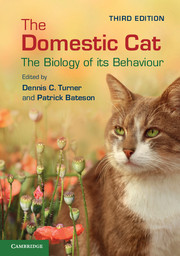Book contents
- Frontmatter
- Contents
- Contributors
- Abbreviations
- I Introduction
- II From Kitten- to Adulthood
- 2 Behavioural development in the cat
- 3 Normal and problematic reproductive behaviour in the domestic cat
- 4 Communication in the domestic cat: within- and between-species
- III Social Life and Ecology
- IV Cats and People
- V Cat Breeding and Cat Welfare
- VI The Future
- References
- Index
2 - Behavioural development in the cat
Published online by Cambridge University Press: 05 December 2013
- Frontmatter
- Contents
- Contributors
- Abbreviations
- I Introduction
- II From Kitten- to Adulthood
- 2 Behavioural development in the cat
- 3 Normal and problematic reproductive behaviour in the domestic cat
- 4 Communication in the domestic cat: within- and between-species
- III Social Life and Ecology
- IV Cats and People
- V Cat Breeding and Cat Welfare
- VI The Future
- References
- Index
Summary
Introduction
As a cat grows up, its characteristics and behaviour develop with regularity and consistency. Most kittens open their eyes during their second week, for example, and start to eat their first solid food at around one month of age. Cats are also adaptable and modifiable in their behaviour, responding sensitively to changes in their environments. Moreover, they are highly variable in their habits. Some domestic cats spend much of their time hunting, while others seldom leave the comfort of their owner’s armchair. Explaining how and why such consistencies and differences arise during development is the main theme of this chapter.
Biology presents many wonders, but one of the most remarkable is how an animal as complex as a cat grows from a single cell. Until recently, the processes involved seemed largely beyond understanding and, even now, much remains to be discovered. Nevertheless, some factual certainties have been self-evident for a long time. Different species in the cat family share many patterns of behaviour in common. The play of the cheetah cub, for example, is strongly reminiscent of the play of a domestic kitten. These ‘robust’ constancies of development are profound and real. At the same time, every cat is capable of adapting to many challenges posed by its environment. It can cope with disabilities generated by accidents or disease. It can learn to recognise particular members of its species and acquire preferences for particular foods that are available to it. Above all, it is highly adaptable, readily solving difficult challenges posed for it in its life. The plasticity of the cat is as remarkable as its robustness. Here, however, lies a trap for the unwary. It does not follow that two distinct processes can be cleanly separated, one leading to an invariant outcome and the other generating an individual’s distinctiveness due to its previous experience over and above its particular genome.
- Type
- Chapter
- Information
- The Domestic CatThe Biology of its Behaviour, pp. 11 - 26Publisher: Cambridge University PressPrint publication year: 2013



